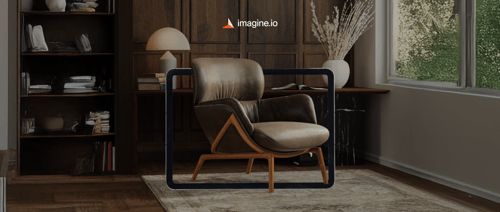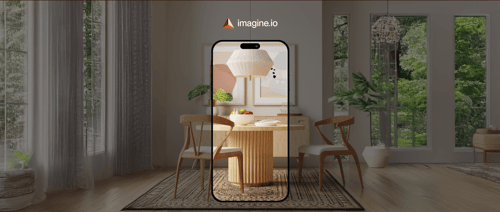Imagine a shopper in New York, browsing an online furniture store, captivated by a linen armchair. The screen showcases every thread, every subtle crease in the fabric, rendered with such clarity it feels tangible. With a click, they switch from charcoal to ivory, watching the chair transform instantly. This isn't a studio photoshoot it's the power of cloud-based platforms like imagine.io, redefining how textile brands bring their products to life in eCommerce.
The Digital Shift in Textile Retail
In markets like the United States and Canada, where textile eCommerce is fiercely competitive, consumers expect more than static images. They demand visuals that reveal the texture of a wool throw or the sheen of a silk pillowcase. A 2024 report from Grand View Research estimates the global visual cloud market at $124.93 billion, with a projected growth rate of 12.7% annually through 2030. This expansion is driven by surging demand for cloud-based solutions powering video streaming, AI-driven analytics, and immersive AR/VR experiences. As high-definition content becomes the norm, cloud platforms are replacing traditional photography, offering brands in cities like Chicago, Los Angeles, and Dallas a faster, more flexible way to meet consumer expectations.
Studio shoots, once the backbone of product imagery, are losing ground. They're expensive, slow, and impractical for brands managing thousands of SKUs. Cloud-based creative tools, however, deliver photorealistic visuals at a fraction of the time and cost, enabling retailers to keep pace with fast-moving markets.
Trends Reshaping Textile eCommerce
Photorealistic 3D rendering is now a cornerstone of textile eCommerce. Cloud platforms can capture the intricate details of fabric think the soft drape of curtains or the embossed pattern of an upholstered sofa with precision that rivals professional photography. imagine.io's internal studies reveal that even seasoned eCommerce professionals struggle to distinguish their cloud-generated images from real photoshoots. This level of quality builds trust, letting shoppers make informed decisions without stepping into a showroom.
Interactive configurators are another leap forward. On platforms like Ruggable or King Koil, customers can adjust colors, patterns, or sizes in real time, seeing instant updates without page refreshes. Augmented reality (AR) tools take this further, allowing shoppers to visualize a rug in their dining room or a throw on their couch. These features don't just engage they empower confident purchases, especially in design-savvy markets like Las Vegas and High Point.
AI-driven asset creation is the engine behind this revolution. By uploading a 3D model to a cloud platform, brands can generate images, videos, 360-degree views, or interactive configurators in minutes. Automated adjustments to lighting, backgrounds, and styling eliminate the need for manual retouching, making it ideal for textile companies with complex catalogs or frequent seasonal updates.
Real-World Impact for Textile Brands
Consider a bedding brand launching a fall collection. Traditionally, they'd spend weeks coordinating studio shoots for every duvet, sheet, and pillowcase. Now, companies like Sinomax-USA or Serta Simmons can upload designs to imagine.io and produce thousands of high-quality assets in hours. The platform's unlimited image generation is a lifeline for retailers with extensive SKU ranges, ensuring every product variant is showcased without ballooning costs.
These tools integrate seamlessly with major eCommerce platforms, enhancing sites like those of Kichler or Hunter Fan. In competitive regions like Austin or New York, where speed and presentation are critical, this capability helps brands differentiate themselves. Social media amplifies the impact photorealistic visuals shared on LinkedIn, Instagram, or YouTube drive engagement, turning casual browsers into buyers.
Overcoming Adoption Barriers
Despite the advantages, some brands hesitate to adopt cloud platforms. A common concern is the subscription model, which contrasts with the one-off costs of project-based work. Yet, subscriptions offer unmatched flexibility unlimited asset creation means no surprise expenses when a new collection launches. imagine.io's pricing, tailored to each client, can seem intricate compared to competitor's flat rates. Transparent communication about the value speed, scalability, and quality helps address this concern.
Another challenge is trust. Many companies rely on established agency pools for creative work, viewing cloud platforms as untested newcomers. However, with clients like Kohler already leveraging imagine.io, these platforms are proving their worth. Rather than replacing agencies, they complement them, offering a tech-driven solution for high-volume visual needs.
Addressing Pricing Concerns
Custom pricing can feel daunting, but it's designed to align with a brand's specific needs. For example, a retailer with a sprawling catalog benefits from unlimited asset generation, while a smaller brand might prioritize interactive tools. By focusing on long-term value fewer shoots, faster launches cloud platforms make a compelling case.
Building Trust with Newcomers
For companies wary of stepping outside their agency pool, the track record of cloud platforms speaks for itself. Success stories from brands in textile-heavy markets like Los Angeles and Chicago demonstrate reliability and ROI, easing concerns about venturing into new technology.
Business Benefits That Drive Growth
Cloud platforms deliver measurable advantages. First, they accelerate time-to-market. Textile brands in fast-paced regions like Dallas or Chicago can launch collections in days, not weeks, staying ahead of trends and competitors. Second, they cut costs. Eliminating repetitive studio shoots for minor design changes frees up budgets for marketing or product development.
Most importantly, high-quality visuals boost consumer confidence. When shoppers can zoom in on a fabric's texture or preview a sofa in their chosen color, they're less likely to return it. This reduces return rates and lifts conversion rates critical metrics for retailers in showroom-driven markets like High Point. The result? A stronger bottom line and a sharper competitive edge.
The Future of Textile Visualization
The textile eCommerce landscape is at a turning point. As Grand View Research notes, advancements in 5G and edge computing are fueling the visual cloud market's growth, enabling real-time, high-performance experiences. Brands that adopt cloud platforms now whether in Canada or Las Vegas aren't just adapting; they're setting the pace for the industry.
The next frontier is hyper-personalization, where shoppers can customize every detail of a product and see it instantly. Platforms like imagine.io, with their all-in-one approach images, videos, 360s, and configurators are built for this future. For textile retailers, the takeaway is clear: visual content isn't a one-time project; it's a scalable, ongoing pipeline. To see how it works, explore imagine.io and discover a new way to weave your brand's story.
Frequently Asked Questions
How do cloud-based platforms improve textile eCommerce product visuals compared to traditional photography?
Cloud-based platforms like imagine.io generate photorealistic 3D renderings that capture intricate fabric details—from the soft drape of curtains to embossed upholstery patterns—with precision that rivals professional photography. Unlike traditional studio shoots that are expensive and time-consuming, cloud platforms can produce thousands of high-quality product images, videos, and 360-degree views in hours rather than weeks. This technology also enables real-time color and pattern changes, eliminating the need for multiple photoshoots when launching new product variants.
What are the key benefits of using AI-powered visual platforms for textile brands?
AI-powered visual platforms deliver three major benefits for textile brands: accelerated time-to-market (launching collections in days instead of weeks), significant cost reduction (cutting production costs up to 70% by eliminating repetitive studio shoots), and improved conversion rates through high-quality visuals that build consumer confidence. These platforms also offer unlimited asset generation, seamless eCommerce integration, and interactive features like AR visualization and product configurators that help customers make informed purchasing decisions.
How do interactive configurators and AR features impact textile eCommerce sales?
Interactive configurators and AR features significantly boost textile eCommerce performance by allowing customers to visualize products in real-time—such as seeing how a rug looks in their dining room or switching fabric colors instantly without page refreshes. These immersive experiences reduce return rates by helping shoppers make more confident purchases, while brands like Ruggable and King Koil have successfully used these tools to increase customer engagement and conversions up to 5X in competitive markets.
Disclaimer: The above helpful resources content contains personal opinions and experiences. The information provided is for general knowledge and does not constitute professional advice.
You may also be interested in: 3D Furniture Configurator & Rendering – Imagine.io
Struggling with expensive, outdated product visuals that slow down your creative process and stunt eCommerce growth? imagine.io's AI-powered platform empowers furniture, home décor, and textile brands to effortlessly produce striking 3D images, immersive videos, AR experiences, and interactive configurators. Cut production costs up to 70%, boost conversions 5X, speed up prototyping, and supercharge your online sales. Ready to elevate your product visuals and captivate customers? Book a demo with imagine.io today!
Powered by flareAI.co




.png?width=500&name=How%20to%20Add%20a%203D%20Product%20Configurator%20to%20Your%20WordPress%20Website%20(Complete%20B2B%20Guide).png)
















%20(1).png?width=500&name=Why%20Exploded%20Mattress%20Views%20Matter%20(And%20How%20to%20Generate%20Them)%20(1).png)
.png?width=500&name=Best%20Shopify%20Product%20Configurator_%20How%20to%20Choose%20the%20Right%20One%20(2).png)
.png?width=500&name=Why%20Exploded%20Mattress%20Views%20Matter%20(And%20How%20to%20Generate%20Them).png)



.png?width=500&name=Best%20Shopify%20Product%20Configurator_%20How%20to%20Choose%20the%20Right%20One%20(1).png)







.png?width=500&name=How%203D%20Rendering%20Can%20Make%20or%20Break%20Your%20Industrial%20Design%20Pitch%20(1).png)








%20with%20Digital%20Twins%20and%203D%20Visualization.png?width=500&name=Optimizing%20Your%20Digital%20Asset%20Management%20(DAM)%20with%20Digital%20Twins%20and%203D%20Visualization.png)




.png?width=500&name=Styling%20Home%20Decor%20for%202025_%20From%20Global%20Influences%20to%20Playful%20Personalization%20(1).png)
